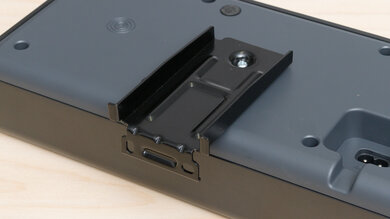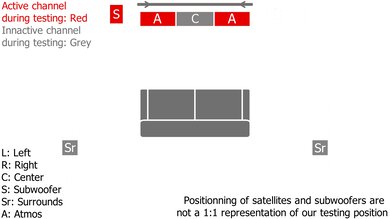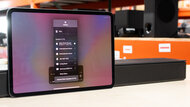The LG S80QR was released in 2022. It's a mid-range offering from LG that's available on its own as the LG S80QY or with the LG SPQ8-S satellites added on for improved surround sound performance. Like the LG S90QY and the LG S95QR, its unique design includes an additional up-firing center channel on top of the bar for higher-quality dialogue reproduction. You also get access to lots of LG's premium features, like the AI Room Calibration tool as well as TV Sound Mode Share for improved sound with compatible LG TVs.
Our Verdict
The LG S80QR is very good for mixed usage. This setup reproduces voices and other lead instruments clearly right out of the box, making it a solid pick for lots of different music genres. With its additional up-firing center channel, it clearly reproduces dialogue in all your favorite movies and TV shows. With the added satellites, you get a pretty immersive feel with movies.
-
Room correction feature.
-
Bass and treble adjustments.
-
Dolby Atmos support.
-
No graphic EQ.
The LG S80QR is great for dialogue-centric TV shows and podcasts. Uniquely, it comes with not one but two center channels, both of which are designed to improve the quality of vocal reproduction. You can easily follow along with the action on screen, and there's even a dialogue enhancement tool on hand if you want to make voices more crisp in the mix. You have lots of options if you want to stream podcasts or audiobooks to the bar, including Bluetooth and Wi-Fi.
-
Room correction feature.
-
Dialogue enhancement tool.
-
No graphic EQ.
The LG S80QR is very good for music. Since it comes with a room correction feature, it automatically optimizes its output based on your room's unique acoustics. Voices and lead instruments are clear in the mix right out of the box, so it's suitable for lots of different genres. You can adjust the bass and the treble based on your preferences. It lacks a touch of low-bass compared to other setups on the market, which is especially noticeable with bass-heavy music like EDM and hip-hop.
-
Room correction feature.
-
Bass and treble adjustments.
-
Lacks a touch of low-bass.
The LG S80QR is very good for movies. Whether you're watching from a streaming platform or a Blu-ray disc, the bar supports lots of common audio formats, including Dolby Digital and Dolby Atmos. Plus, the added satellites improve its overall performance, so you get a more clear and real feel with your favorite films. Sound stretches into the space around your couch, so you feel like you're right in the middle of the action. That said, the lack of low-bass is a touch noticeable with action-packed scenes, especially in comparison with other premium setups on the market.
-
Room correction feature.
-
Dialogue enhancement tool.
-
Dolby Atmos support.
-
Lacks a touch of low-bass.
- 7.9 Mixed Usage
- 8.1 Dialogue/TV Shows
- 7.9 Music
- 7.8 Movies
Changelog
-
Updated Mar 07, 2025:
We mentioned the LG S80TR in the Style - Satellites section of this review.
- Updated Apr 30, 2024: We've added a comparison between this soundbar and the Samsung HW-Q700C with SWA-9500S in Stereo Soundstage.
- Updated May 16, 2023: Added market comparison with the LG S75QR in the Stereo Frequency Response box.
- Updated Mar 27, 2023: Added cable lengths to In The Box.
- Updated Mar 22, 2023: Converted to Test Bench 1.1. With this update, we've added a Mounting test and added information aboutSubwoofer Output, Spotify Connect, and Microphone Mute.
Check Price
Differences Between Sizes And Variants
You can buy the LG S80QY with only the soundbar and the subwoofer. However, the results in this review apply to the LG SQ80Y with SPQ8-S speaker kit, also known as the LG S80QR soundbar, which includes the satellites as well.
They're available in black, and you can see the label for the satellites here.
Popular Soundbars Comparisons
The LG S80QR is a 5.1.3 soundbar from the manufacturer's 2022 lineup. Compared to the LG S80QY on its own, the added satellites make for an improved surround sound experience, resulting in a more clear and real reproduction of sound effects in the space around you. Otherwise, the features offered between these bars are the same.
See also our recommendations for the best soundbars, the best 5.1 soundbars, and the best Dolby Atmos soundbars.
The LG S80TR is the successor to the LG S80QR, and both soundbars offer nearly identical performance. The key advantage of the S80TR is its simplified setup—its subwoofer and satellites connect wirelessly to the main bar, eliminating the need for a separate wireless transmitter. If space for the S80QR’s small transmitter isn’t an issue, either model is a solid choice, so go with whichever is more affordable.
The LG S80QR is the same as the LG S80QY but comes with the SPQ8-S rear speaker kit, improving the overall surround sound performance. Satellites help to reproduce sound effects in a more clear and real way, so sound stretches into the space around your room for an immersive feel with both 5.1 surround and Dolby Atmos content.
The LG S95QR is better than the LG S80QR. They're both Dolby Atmos soundbars with similar features, including AI Room Calibration and TV Sound Mode Share. However, the S95QR has a 9.1.5 setup, meaning that its satellites come with additional channels compared to the SPQ8-S speakers, which improve its surround sound and Atmos performances. Plus, it offers a better stereo soundstage.
The LG S80QR is better than the LG S75QR. The S80QR is a 5.1.3 setup with an additional up-firing center channel to improve vocal reproduction in the mix. It offers more features, too, such as room correction and Wi-Fi support. It also has a better low-frequency extension, so you notice more low-bass in the mix.
The LG S80QR is a bit better than the LG SP9YA. This is especially true if you like to watch a lot of surround sound or Dolby Atmos content since the SPQ8-S Speaker Kit improves its performance in this regard. If you don't have space for satellites, the SP9YA is a good alternative.
The LG S80QR is a bit better than the LG S90QY overall. The LG S90QY is a 5.1.3 setup with phantom surround drivers built into the bar itself. Since it lacks satellites, it's great if you're low on space. However, dedicated surround speakers like the SPQ8-S noticeably improve the S80QR's performance with Atmos and surround sound content. You can also add this speaker kit to the S90QY if you want to improve its performance.
The LG S80QR is similar to the LG S90QY with SPQ8-S Speaker Kit in many regards. However, the S90QY comes with two more side-firing surround channels. It doesn't make a massive difference in the sound, but the S90QY does offer a better soundstage overall, so you feel more immersed in your audio.
The LG S80QR and the Samsung HW-Q700C with SWA-9500S are similarly designed setups. The LG is a solid choice for TV shows and other kinds of dialogue-centric content as it has a more neutral sound profile, which some users may prefer, and it can reach its max volume with fewer compression artifacts, so if you're using it to play music during a noisy house party, your audio still sounds clean. The Samsung will be the better choice if you're really into movies and gaming. It has better surround and height performances to make content feel more dimensional and immersive and supports video passthrough.
Test Results
The LG SPQ8-S are speakers with a similar build to the soundbar itself. They're mostly made of plastic, and fabric covers the front and the sides. They connect to a wireless receiver that's made of the same plastic. If you'd prefer not to deal with an extra box, the LG S80TR is the successor to this soundbar and offers wireless connections to the subwoofer and satellites without the need for an extra box.
The speakers have a similar size compared to other models on the market. However, you have to wire them to the included wireless receiver, which limits their placement a bit.
The wireless receiver module is 6.9" (17.5 cm) wide, 2.3" (6 cm) tall, and 7.2" (18.3 cm) deep.
The LG S80QR has a very good stereo frequency response. A room calibration tool is available to optimize its output based on your room's unique characteristics. With it on, the bar has a decent overall sound, with a clear and accurate reproduction of voices and lead instruments that makes it suitable for listening to most types of audio content. However, there's a little extra emphasis in the high-bass that adds a bassy quality to certain tracks and a dip in the low-treble that pushes higher-pitched instruments like cymbals toward the back of the mix. You also don't notice as much rumble in the low-bass as with other premium setups, though it does better than comparable models like the LG S75QR.
Note: There's a slight difference in the slope between the LG S80QY on its own and the same bar with the LG SPQ8-S speaker kit. It's likely due to testing variation and possible differences in the acoustic characteristics of our testing room during the room calibration process. Still, you aren't likely to notice a major difference in stereo sound with or without the speaker kit.
If you prefer a more balanced sound with stereo content, set the bass to -3 and the treble to 3. The resulting sound is more even, with less boom in the high-bass, so you don't notice as much of a bassy sound with certain tracks. The added emphasis in the treble brings more accuracy to the reproduction of higher-pitched sounds like cymbals.
The LG S80QR has a decent stereo soundstage. The soundstage is perceived to be a bit wider than the bar, but it doesn't have any tricks to make it stretch past that. Also, unlike the Samsung HW-Q700C with SWA-9500S, sound objects like instruments seem to come from more general areas in the space around you rather than from pinpoint locations.
The LG S80QR gets fairly loud, so it fills average living rooms with sound easily. Plus, as you push it to max volume, there isn't a lot of compression, so audio reproduction remains clean and pure.
The LG S80QR has a fair stereo THD performance. At a normal listening volume, distortion falls within good limits, so audio is reproduced with clarity. While there's a slight jump when you push the bar to max volume, it's important to remember that distortion is really hard to hear with real-life content.
This soundbar's unique design includes a traditional front-firing center channel as well as an up-firing center channel on top of the bar. Overall, its center channel performance is great. Thanks to its balanced response, voices are clear and present in the mix, and it's easy to follow along with the action on screen. However, the additional center channel doesn't make the bar's performance stand out—in fact, its performance is similar to other bars on the market with only one front-firing center channel.
The added speakers make a noticeable difference in the bar's surrounds performance compared to the standalone LG S80QY. Thanks to its discrete surrounds, audio seems more clear and real in the space around you. Sound effects are localized to more accurate positions within the space around your couch, so you get more of a feeling of action taking place all around you. That said, the uneven graph means that certain frequencies are more pronounced than others, making it seem as if some details are more emphasized than others in the mix.
The LG S80QR has three up-firing drivers. Two of them ricochet sound off the ceiling to create the illusion of height, while the up-firing center driver only plays center content. While the bar's performance isn't as real-sounding as what you get with a dedicated home theater setup, it still does a fair job compared to other soundbars. Dialogue and other sound effects are fairly clear in the mix, and the sub brings some rumble in the low-bass during action-packed scenes.
Subjectively, the added speakers improve the bar's Atmos performance compared to the standalone bar. Sound effects seem to stretch to the space around your couch, so you feel like the action is taking place all around you. That said, it's not quite as impressive as other premium setups on the market, as it struggles to replicate sounds that are meant to come above you, like drones flying past. Some details seem to be emphasized more than others, as suggested by the uneven frequency response. Unfortunately, this makes it feel like the rears aren't properly integrated into the sound.
The LG S80QR comes with a lot of sound enhancement features to help you switch up its sound. Like other premium setups, its AI Room Calibration feature adjusts the bar's output based on your room's unique acoustics, which you can activate through the app. There are bass and treble adjustments on hand, too, as well as some EQ presets: 'Standard', 'Bass Blast', 'AI Sound Pro', 'Cinema', 'Sports', 'Game', 'Clear Voice', and 'Music'.
It's not uncommon to see soundbars with special features that allow you to integrate your setup with a TV from the same brand. This bar is no different, as it supports LG's TV Sound Mode Share for enhanced sound. Unfortunately, like most of these features, it doesn't change the sound quality—there's hardly any difference in the frequency response or the soundstage as a result. If you use the bar with another brand's TV, you won't notice a huge difference in the sound.
If you want to use this soundbar with your TV, you can connect it over an HDMI or Optical connection. It's compatible with LG's WOWCAST, which the manufacturer says lets you pair the bar to your TV wirelessly.
The bar supports lots of different audio formats over ARC. You can playback common surround sound formats like Dolby Digital as well as lossless and object-based formats like Dolby Atmos.
Via Full HDMI In, the bar also supports a wide array of audio formats that are commonly found on streaming platforms and Blu-ray discs, like Dolby Atmos.
Over an Optical connection, the bar can play back Dolby Digital and DTS content, which is handy if you watch a lot of content on streaming platforms.
The bar's latency performance makes it well-suited to watching videos and movies. You won't notice delays between the audio you hear and the video you see. Some apps and TVs compensate for latency differently. If you have any issues, you can use the AV Sync feature in the app to adjust the delay.
You can stream audio from your mobile devices to the bar over many different platforms, from Bluetooth to Spotify Connect.
This bar can passthrough high-quality bandwidth signals, and there's also Dolby Vision Passthrough support. When you use it as a hub between your TV and your PC, text on the screen is clear and crisp. It can't passthrough 4k @ 120Hz, though.
Comments
LG S80QR: Main Discussion
Let us know why you want us to review the product here, or encourage others to vote for this product.
Update: We mentioned the LG S80TR in the Style - Satellites section of this review.
- 21010
Wife & I have moderate hearing impairment, mostly higher frequencies. Tried the S65Q - really superb for enhancing conversation, but defective. Took it back, upgraded to S80QY - HUGELY disappointed. Clear Voice Pro sounds like it’s coming from inside a can, AI Sound Pro seems pretty much the same other than more/less bass.
Overall, I MUCH prefer the midrange quality of the S65Q over the S80QY. Wish I had just exchanged the S65Q instead of doubling the money for the S80QY, which sounds truly mediocre.
Update: Added market comparison with the LG S75QR in the Stereo Frequency Response box.









































